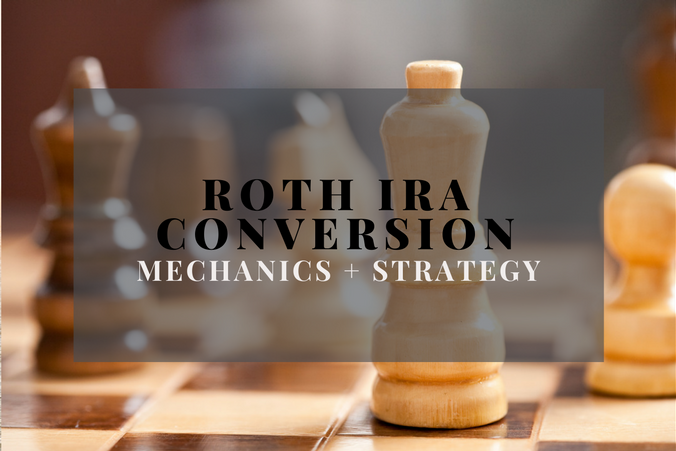
Roth IRA Conversion – Mechanics and Strategy
- Consider converting a traditional IRA to a Roth IRA
- Roth conversions can be recharacterized (i.e. un-done)
- Combine conversion with recharacterization to maximize one’s flexibility
This is the time of year when we encourage clients and prospective clients to consider a Roth IRA conversion. Enough of the year is in the bag to allow a fairly accurate picture of one’s tax situation, with the help of a tax professional or tax planning software. That’s an important consideration, as a Roth conversion is a taxable event that will impact one’s income tax. If possible and with all other things equal, one should convert IRAs in years when one’s income is lower rather than higher. This short piece will look at the mechanics of the Roth conversion and at a Roth conversion strategy.
First, here are some benefits of having Roth funds in one’s retirement plan. This list is not exhaustive:
- Tax diversification. Since no one knows what tax rates will be in the future, having Roth funds can help mitigate that uncertainty. It provides an additional option when coming up with a retirement fund withdrawal strategy.
- Estate planning tool. Required minimum distributions (RMD) are not a feature of Roth IRAs, so, as compared to a traditional IRA, which does have RMDs, more wealth can be transferred to beneficiaries.
In a Roth IRA conversion, a traditional IRA is converted to a Roth IRA, and the amount converted is subject to income tax, which tax can be paid from within the converted IRA (called a tax-inclusive conversion) or from without (called a tax-exclusive conversion), the latter of which also includes a 10% penalty on funds used to pay the tax for an IRA holder younger than 59 ½. All other things equal, the tax-inclusive strategy is to be preferred, as the full balance is transferred to the Roth IRA. The Roth IRA offers tax deferral on any earnings in the account.
Some company retirement plans (e.g. 401(k)) may allow in-plan conversions to a Roth 401(k), but taxes on these conversions must be paid with funds from outside the plan.
Let’s look at a Roth conversion example. Jim expects his income in the current year to be less than usual, such that his federal income tax rate will be 25%. He elects to convert $50,000 of his traditional IRA to a Roth IRA, adding $12,500 ($50,000 x 25%) to his tax bill for the year, keeping himself in the 25% tax bracket.
Imagine, though, that the market declines after the conversion occurs, and Jim’s Roth declines in value by 20% to $40,000. If he had waited to do the Roth conversion until then, his tax bill on the conversion would have been just $10,000.
In this case, Jim can recharacterize his Roth IRA back to a traditional IRA, although he only has until October 15 of the year following the conversion, which is the latest date he can file his taxes. (If he already filed his taxes, he can file an amended return.) This recharacterization effectively undoes the conversion.
This presents a Roth-conversion strategy for folks considering same. Since Roth IRAs can’t be partially recharacterized, and since certain types of investments are more likely to be more volatile than others—stock investments more than bond investments, for example—several Roth IRAs can be created. For example, one could convert individual stock holdings to one Roth IRA (Roth #1); riskier asset-class investments to another (Roth #2); and bond funds to a third Roth IRA (Roth #3). Each of these Roth IRAs are likely to perform differently, and each can be recharacterized as and if needed.
- Roth #1 – performs well; account rises by 9%
- Roth #2 – emerging markets perform terribly; account declines by 22%
- Roth #3 – bond investments serve their traditional role of providing lower volatility; account rises by 3%
Assuming this occurs in time to recharacterize the Roth IRAs, Roth #2 would be recharacterized, while Roths 1 and 3 would continue. Then, after October 15, all existing Roth IRAs can be combined to reduce custodial fees, etc.
There are a couple of caveats to consider. Any Roth’s recharacterized back to traditional IRAs can’t be converted to Roths, again, until the later of 30 days or the next calendar year. Also, recharacterization is a limited-time hedge against a market-related decline. After October 15, recharacterization is no longer allowed.
As always, complex transactions and/or those that involve taxes should be discussed with competent professional counsel.
This information is not intended to be a substitute for individualized tax advice.
Roth IRA account owners should consider the potential tax ramifications, age and contribution deductibility limits in regard to executing a re-characterization of a Roth IRA to a Traditional IRA.
Traditional IRA account owners should consider the tax ramifications, age and income restrictions in regards to executing a conversion from a Traditional IRA to a Roth IRA.
Roth IRA withdrawals prior to age 59 ½ or prior to the account being opened for 5 years, whichever is later, may result in a 10% IRS penalty tax. Future tax laws can change at any time and may impact the benefits of Roth IRAs. Their tax treatment may change.
Bonds are subject to market and interest rate risk if sold prior to maturity. Bond values will decline as interest rates rise and bonds are subject to availability and change in price.
